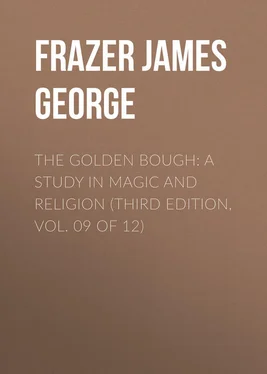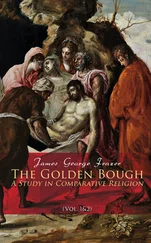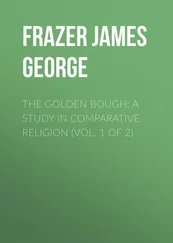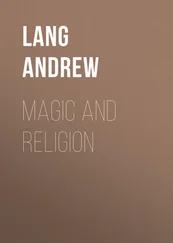James Frazer - The Golden Bough - A Study in Magic and Religion (Third Edition, Vol. 09 of 12)
Здесь есть возможность читать онлайн «James Frazer - The Golden Bough - A Study in Magic and Religion (Third Edition, Vol. 09 of 12)» — ознакомительный отрывок электронной книги совершенно бесплатно, а после прочтения отрывка купить полную версию. В некоторых случаях можно слушать аудио, скачать через торрент в формате fb2 и присутствует краткое содержание. Жанр: foreign_religion, foreign_antique, foreign_prose, на английском языке. Описание произведения, (предисловие) а так же отзывы посетителей доступны на портале библиотеки ЛибКат.
- Название:The Golden Bough: A Study in Magic and Religion (Third Edition, Vol. 09 of 12)
- Автор:
- Жанр:
- Год:неизвестен
- ISBN:нет данных
- Рейтинг книги:3 / 5. Голосов: 1
-
Избранное:Добавить в избранное
- Отзывы:
-
Ваша оценка:
- 60
- 1
- 2
- 3
- 4
- 5
The Golden Bough: A Study in Magic and Religion (Third Edition, Vol. 09 of 12): краткое содержание, описание и аннотация
Предлагаем к чтению аннотацию, описание, краткое содержание или предисловие (зависит от того, что написал сам автор книги «The Golden Bough: A Study in Magic and Religion (Third Edition, Vol. 09 of 12)»). Если вы не нашли необходимую информацию о книге — напишите в комментариях, мы постараемся отыскать её.
The Golden Bough: A Study in Magic and Religion (Third Edition, Vol. 09 of 12) — читать онлайн ознакомительный отрывок
Ниже представлен текст книги, разбитый по страницам. Система сохранения места последней прочитанной страницы, позволяет с удобством читать онлайн бесплатно книгу «The Golden Bough: A Study in Magic and Religion (Third Edition, Vol. 09 of 12)», без необходимости каждый раз заново искать на чём Вы остановились. Поставьте закладку, и сможете в любой момент перейти на страницу, на которой закончили чтение.
Интервал:
Закладка:
Evils transferred to animals in India.
Among the Majhwar, a Dravidian race of South Mirzapur, if a man has died of a contagious disease, such as cholera, the village priest walks in front of the funeral procession with a chicken in his hands, which he lets loose in the direction of some other village as a scapegoat to carry the infection away. None but another very experienced priest would afterwards dare to touch or eat such a chicken. 117 117 W. Crooke, Tribes and Castes of the North-Western Provinces and Oudh (Calcutta, 1896), iii. 434.
Among the Badagas of the Neilgherry Hills in Southern India, when a death has taken place, the sins of the deceased are laid upon a buffalo calf. For this purpose the people gather round the corpse and carry it outside of the village. There an elder of the tribe, standing at the head of the corpse, recites or chants a long list of sins such as any Badaga may commit, and the people repeat the last words of each line after him. The confession of sins is thrice repeated. “By a conventional mode of expression, the sum total of sins a man may do is said to be thirteen hundred. Admitting that the deceased has committed them all, the performer cries aloud, ‘Stay not their flight to God's pure feet.’ As he closes, the whole assembly chants aloud ‘Stay not their flight.’ Again the performer enters into details, and cries, ‘He killed the crawling snake. It is a sin.’ In a moment the last word is caught up, and all the people cry ‘It is a sin.’ As they shout, the performer lays his hand upon the calf. The sin is transferred to the calf. Thus the whole catalogue is gone through in this impressive way. But this is not enough. As the last shout ‘Let all be well’ dies away, the performer gives place to another, and again confession is made, and all the people shout ‘It is a sin.’ A third time it is done. Then, still in solemn silence, the calf is let loose. Like the Jewish scapegoat, it may never be used for secular work.” At a Badaga funeral witnessed by the Rev. A. C. Clayton the buffalo calf was led thrice round the bier, and the dead man's hand was laid on its head. “By this act, the calf was supposed to receive all the sins of the deceased. It was then driven away to a great distance, that it might contaminate no one, and it was said that it would never be sold, but looked on as a dedicated sacred animal.” 118 118 E. Thurston, Castes and Tribes of Southern India (Madras, 1909), i. 113-117; id. , Ethnographic Notes in Southern India (Madras, 1906), pp. 192-196; Captain H. Harkness, Description of a Singular Aboriginal Race inhabiting the Summit of the Neilgherry Hills (London, 1832), p. 133; F. Metz, The Tribes inhabiting the Neilgherry Hills , Second Edition (Mangalore, 1864), p. 78; Jagor, “Ueber die Badagas im Nilgiri-Gebirge,” Verhandlungen der Berliner Gesellschaft für Anthropologie (1876), pp. 196 sq. At the Badaga funerals witnessed by Mr. E. Thurston “no calf was brought near the corpse, and the celebrants of the rites were satisfied with the mere mention by name of a calf, which is male or female according to the sex of the deceased.”
“The idea of this ceremony is, that the sins of the deceased enter the calf, or that the task of his absolution is laid on it. They say that the calf very soon disappears, and that it is never after heard of.” 119 119 H. Harkness, l. c.
Some of the Todas of the Neilgherry Hills in like manner let loose a calf as a funeral ceremony; the intention may be to transfer the sins of the deceased to the animal. Perhaps the Todas have borrowed the ceremony from the Badagas. 120 120 J. W. Breeks, An Account of the Primitive Tribes and Monuments of the Nīlagiris (London, 1873), pp. 23 sq. ; W. H. R. Rivers, The Todas (London, 1906), pp. 376 sq.
In Kumaon, a district of North-Western India, the custom of letting loose a bullock as a scapegoat at a funeral is occasionally observed. A bell is hung on the bullock's neck, and bells are tied to its feet, and the animal is told that it is to be let go in order to save the spirit of the deceased from the torments of hell. Sometimes the bullock's right quarter is branded with a trident and the left with a discus. 121 121 E. T. Atkinson, The Himalayan Districts of the North-Western Provinces of India , ii. (Allahabad, 1884) pp. 927 sq. In other parts of North-Western India on the eleventh day after a death a bull calf is let loose with a trident branded on its shoulder or quarter “to become a pest.” See (Sir) Denzil C. J. Ibbetson, Report on the Revision of Settlement of the Panipat Tahsil and Karnal Parganah of the Karnal District (Allahabad, 1883), p. 137. In Behar, a district of Bengal, a bullock is also let loose on the eleventh day of mourning for a near relative. See G. A. Grierson, Bihār Peasant Life (Calcutta, 1885), p. 409.
Perhaps the original intention of such customs was to banish the contagion of death by means of the animal, which carried it away and so ensured the life of the survivors. The idea of sin is not primitive.
§ 4. The Transference to Men
Evils transferred to human beings in India and elsewhere.
Again, men sometimes play the part of scapegoat by diverting to themselves the evils that threaten others. An ancient Hindoo ritual describes how the pangs of thirst may be transferred from a sick man to another. The operator seats the pair on branches, back to back, the sufferer with his face to the east, and the whole man with his face to the west. Then he stirs some gruel in a vessel placed on the patient's head and hands the stir-about to the other man to drink. In this way he transfers the pangs of thirst from the thirsty soul to the other, who obligingly receives them in his stead. 122 122 W. Caland, Altindisches Zauberritual (Amsterdam, 1900), p. 83; Hymns of the Atharva-Veda , translated by Maurice Bloomfield (Oxford, 1897), pp. 308 sq. ( Sacred Books of the East , vol. xlii.).
There is a painful Telugu remedy for a fever: it is to embrace a bald-headed Brahman widow at the earliest streak of dawn. By doing so you get rid of the fever, and no doubt (though this is not expressly affirmed) you at the same time transfer it to the bald-headed widow. 123 123 M. N. Venketswami, “Telugu Superstitions,” The Indian Antiquary , xxiv. (1895) p. 359.
When a Cinghalese is dangerously ill, and the physicians can do nothing, a devil-dancer is called in, who by making offerings to the devils, and dancing in the masks appropriate to them, conjures these demons of disease, one after the other, out of the sick man's body and into his own. Having thus successfully extracted the cause of the malady, the artful dancer lies down on a bier, and shamming death, is carried to an open place outside the village. Here, being left to himself, he soon comes to life again, and hastens back to claim his reward. 124 124 A. Grünwedel, “Sinhalesische Masken,” Internationales Archiv für Ethnographie , vi. (1893) pp. 85 sq.
In 1590 a Scotch witch of the name of Agnes Sampson was convicted of curing a certain Robert Kers of a disease “laid upon him by a westland warlock when he was at Dumfries, whilk sickness she took upon herself, and kept the same with great groaning and torment till the morn, at whilk time there was a great din heard in the house.” The noise was made by the witch in her efforts to shift the disease, by means of clothes, from herself to a cat or dog. Unfortunately the attempt partly miscarried. The disease missed the animal and hit Alexander Douglas of Dalkeith, who dwined and died of it, while the original patient, Robert Kers, was made whole. 125 125 J. G. Dalyell, Darker Superstitions of Scotland (Edinburgh, 1834), pp. 104 sq. I have modernised the spelling.
The Dyaks believe that certain men possess in themselves the power of neutralizing bad omens. So, when evil omens have alarmed a farmer for the safety of his crops, he takes a small portion of his farm produce to one of these wise men, who eats it raw for a small consideration, “and thereby appropriates to himself the evil omen, which in him becomes innocuous, and thus delivers the other from the ban of the pemali or taboo.” 126 126 J. Perham, “Sea Dyak Religion,” Journal of the Straits Branch of the Royal Asiatic Society , No. 10 (December 1882), p. 232.
Интервал:
Закладка:
Похожие книги на «The Golden Bough: A Study in Magic and Religion (Third Edition, Vol. 09 of 12)»
Представляем Вашему вниманию похожие книги на «The Golden Bough: A Study in Magic and Religion (Third Edition, Vol. 09 of 12)» списком для выбора. Мы отобрали схожую по названию и смыслу литературу в надежде предоставить читателям больше вариантов отыскать новые, интересные, ещё непрочитанные произведения.
Обсуждение, отзывы о книге «The Golden Bough: A Study in Magic and Religion (Third Edition, Vol. 09 of 12)» и просто собственные мнения читателей. Оставьте ваши комментарии, напишите, что Вы думаете о произведении, его смысле или главных героях. Укажите что конкретно понравилось, а что нет, и почему Вы так считаете.












